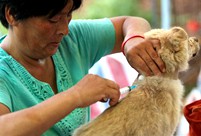

III. On Economic and Social Rights
Despite the gradual recovery of the U.S. economy in 2014, unemployment and poverty still threatened the basic right of survival for the U.S. people. The living conditions for homeless people continuously deteriorated; the income and property gaps caused by distribution inequality continued to enlarge; ordinary people's rights of health and education could not be well ensured as relative resources were more frequently used to serve the rich.
Unemployment posed threat to people's basic right of survival. According to the figures released by the Bureau of Labor Statistics (BLS), the unemployment rate of the U.S. in January 2015 stood at 5.7 percent, with some nine million people jobless and 2.8 million of them having been unemployed for 27 weeks or longer. The unemployment rate for teenagers (18.8 percent) increased in January (www.bls.gov). Although overall U.S. unemployment has fallen in 2014, seven million Americans could only find part-time positions. The number of people working part-time involuntarily is more than 50 percent higher than when the recession began, and almost 30 percent of involuntary part-time workers were unemployed for at least three months in a year (money.cnn.com, November 20, 2014). The unemployment risk forced more people to work on dangerous positions. The BLS data showed that 734 contract workers were killed on the job in the U.S. in 2013, increasing by 35 percent from the 2011 number. A bill known as the Protecting America's Workers Act has been proposed in every Congress since 2004 but has never made it out of committee (www.wsws.org, October 15, 2014).
Poverty rate remained high. Research showed that over 14.5 percent of Americans (about 45 million) lived below the poverty line in 2013, of whom 27.2 percent were African Americans (about 11 million). About 42.5 percent of the African American single-mother families and 14.6 percent of people aged 65 and above (about 6.5 million) lived in poverty (www.huffingtonpost.com, September 16, 2014; seniorjournal.com, October 17, 2014). The high poverty rate left one in seven Americans relying on food pantries and meal service programs to feed themselves and their families (www.usatoday.com, August 17, 2014). Nearly one in five New Yorkers, 1.4 million people, relied on food pantries and soup kitchens across the city to eat. That represented an increase of 200,000 people in five years (The New York Daily News, March 17, 2014). An estimated 322,300 people in 17 Northeast Florida Counties turned to food pantries and meal service programs to feed themselves and their families, and 29 percent were children under age 18 (www.feedingnefl.org, August 27, 2014). On October 20, 2014, the Special Rapporteur on the human right to safe drinking water and sanitation and Special Rapporteur on adequate housing of the United Nations voiced their concerns on the cutting-off of water supply for the families that could not pay the water bills in Detroit City, considering it a violation to the right of access to drinking water and other international basic human rights.
The basic living conditions for homeless people deteriorated. Statistics showed that the homeless population reached to over 610,000 in the U.S. in 2014, including high levels of child, youth and veteran homelessness (america.aljazeera.com, May 28, 2014). In recent years, homelessness in New York City has reached the highest levels since the Great Depression of the 1930s. The Basic facts about homelessness: New York City, released by the Coalition for the Homeless in November 2014 showed that in September 2014, there were an all-time record 58,056 homeless people, including 24,631 homeless children (www.coalitionforthethomeless.org). An estimated 850 families in Washington D.C. were projected to be homeless in the winter of 2014, a 16 percent increase from the year before (The Washington Post, October 14, 2014). However, the number of cities that prohibit sleeping in vehicles jumped from 37 in 2011 to 81 in 2014. The number that prohibit sitting or lying in public spaces increased from 70 in 2011 to 100 in 2014 (www.usatoday.com, July 16, 2014). In the U.S., 21 cities have managed to pass legislation banning or restricting organizations from sharing food with homeless populations in public places since January 2013 alone, according to a report by the National Coalition for the Homeless (www.theguardian.com, November 30, 2014). The city of San Jose in California is known as one of the world's most opulent locations, however, San Jose and the surrounding Santa Clara County estimated almost 7,600 homeless people in 2013. In early December 2014, city officials planned to begin shutting down the encampments built by the homeless people along a creek bed. The majority of the people have said they don't know what they're going to do (The Los Angeles Times, December 4, 2014).
 |
 4-year-old cute 'monk' spends summer holiday in temple
4-year-old cute 'monk' spends summer holiday in temple College graduates shining on the red carpet in Nanjing
College graduates shining on the red carpet in Nanjing PLA soldiers launch guided missiles in confrontation exercise
PLA soldiers launch guided missiles in confrontation exercise One woman’s fight against dog eaters
One woman’s fight against dog eaters Beautiful and smart - post-90s college teacher goes viral
Beautiful and smart - post-90s college teacher goes viral Top 10 luxury houses in the world
Top 10 luxury houses in the world  National Geographic: best photos during journey
National Geographic: best photos during journey Couples who engage in meaningful and deep conversations are happier
Couples who engage in meaningful and deep conversations are happier Maldives resort rated best hotel of 2015
Maldives resort rated best hotel of 2015  Could China and US afford a break-up?
Could China and US afford a break-up?  One woman’s fight against dog eaters
One woman’s fight against dog eaters Addicted to oil
Addicted to oil Growth does not have to reach 7%: minister
Growth does not have to reach 7%: ministerDay|Week